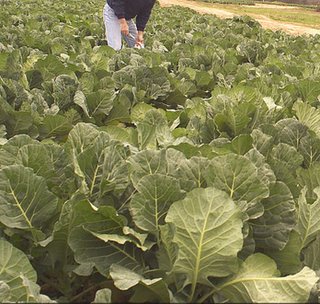
Their teeth must have been HUGE! There were NO footprints! But "it" or "they" ruined the crop in a single night! In ONE night . . . with no legs?
But that was only part of the problem. "Something" loved collard greens as much as we did. For the dedicated collard gardener, a quick consultation with legendary gardener, Felder Rushing, gave the unlikely answer.
The diagnosis? . . . Slugs!
Yes, slugs! But there must be thousands of them! What to do? . . . Beer! Yes, beer! According to Rushing those little sots absolutely can't pass up a drink!
The bottoms cut from disposable muffin tins with a couple of tablespoons of beer each would have 20 to 30 of the useless eaters drowned each morning. That allowed newly planted collard sets to survive! Ah, the vagaries of collard gardening.
The Whole Story (from Chapter 4 of The Collard Patch)
When you begin growing your own collards, you’ll find the sets develop tiny holes in the leaves in the dark of the night, an hour at which any self-respecting predator should be asleep. That’s right—never a tooth showed itself in my collard patch during daylight.
Sometimes it was serious loss of leaf space early in their growth when the plants needed it most. Who were the useless eaters?
Obviously, an intelligence operation was in order! Creeping around under cover of darkness with a red-lensed flashlight à la TV series, Alias, I located the monsters!
Slugs! . . . and a few snails.
The slimy little rascals were quietly but very effectively gnawing on my collard sets. I never knew their squirming slimy soft bodies had teeth! But there they were stuffing great chunks of my precious little collard leaves in their slimy faces. The nerve!
Once again, the Internet came to the rescue of this erstwhile collard culturist. The solution? Beer! No pun intended.
That’s right, beer! I first located this recommendation on a site from foggy England. Feeling the writer may have merely used that as a cover for his excessive ale consumption, I explored further. Next I located similar advice on a site in the good old US of A. Perhaps they were a bit tipsy, too.
I rattled off an e-mail to the master of Southern gardening, Mississippian Felder Rushing—www.FelderRushing.com. I had recently met him and knew him to be stone sober . . . at least at the time of his lecture. Felder replied that, indeed, beer was an attractant due to its yeast odor. I used small open containers, such as the bottom of aluminum disposable muffin tins cut apart with scissors or drink cans cut to a 1.5 inch depth, placed three feet apart, emptied and recharged daily with about ½ inch of beer.
Felder suggested an alternative would be to take a small container with a lid, such as a butter tub or a coffee can, bore a hole in the lid making it big enough to accommodate snails, too, bury it close to the collard plants flush with the ground, and bait it with a small amount of beer. The slugs and snails can crawl through its hole and drown without being able to escape. Every several days the gardener can dispose of the slimy contents over the fence without having to look at the mess, then re-beer and re-bury the traps.
Talk about all natural organic methods!
It serves them drunken little sots right!
The Rest of the Story (from Chapter 5 of The Collard Patch)
For any who resist the wholly natural beer solution to slugs and snails, or who care to avoid purchasing alcohol for others to drink, Felder Rushing also suggested the use of day-old banana peels. It seems that slugs and snails love said peels, but you must mix commercial slug bait on and around some small pieces of the banana peel; otherwise you simply offer them a more varied menu producing more slug and snail reproduction.
After all, you do intend to eradicate them rather than simply fattening them up, don’t you?
Create a “slug haven,” such as a small board raised an inch or two off the ground, where birds and dogs can’t get to the bait.
Another organic solution is to use diatomaceous earth or well-rinsed shells from hard-boiled eggs finely crushed. Sprinkle the items on the soil around the collard plants. These materials are very sharp and cut the fragile bodies of snails and slugs as they crawl over the materials causing them to dry out and die.
One could also sprinkle these materials around pieces of banana peel simply to draw the snails and slugs away to something they prefer to eat.
----------------------------------
(For this and more delightful stories AND the best collard greens and cornbread recipes you'll ever put in your mouth, get The Collard Patch at www.CollardLovers.com! If you think you don't like collards, you haven't tasted our collards! —Paul Elliott and Mary Cheatham)
© 2006 Blue Moon Books—Louisiana
Written by:Paul Elliott
paule@fni.com
